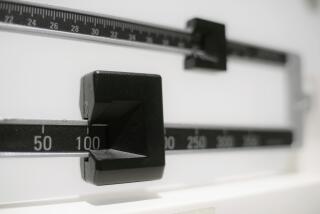After ‘Loser,’ a return to reality
There is life after appearing on “The Biggest Loser,” but much of it is spent at the gym. Many of the contestants report initially regaining at least some weight after the show, then boosting their exercise to bring it back down. All the contestants contacted for this article have adopted radical lifestyle changes to accommodate more exercise, while still controlling their eating.
Moe Walker, a series favorite in season one, was 100 pounds heavier than any of the other contestants at 436 pounds when he came to the ranch. He had lost 71 pounds by the finale, then went home and regained about 50 pounds over the next five months. He then got his weight under control and is down 122 pounds from his starting point.
Walker spends 2 1/2 hours in the gym four days a week. On a typical day he spends an hour on the treadmill, 30 minutes on the recumbent bike and an hour on weights. He tries to restrict his calories to 1,500 to 1,700 day. But after his experience on the ranch, his new exercise regimen is piece a of cake, he says.
After the five and six hours of exercise a day at the ranch, “I feel like I’m slacking off,” he says.
Matt Hoover, season two’s biggest loser, started at 339 pounds and lost 157 pounds on the show. He has since regained about 27 pounds, but can live with that. He feels that his final weight was artificially low.
“I have learned that I can’t base how I look on the weight I was for the finale,” he says.
He works out six days a week and is in training for an upcoming wrestling match. A typical routine includes 45 minutes of cardio training, 30 minutes of weight training and an hour of wrestling. He consumes about 1,600 calories a day.
Hoover, who fell in love with and married another contestant on the show, recently took a job as a personal trainer at a local gym.
“I can’t believe how much my life has changed from a year ago,” he says. “I don’t do anything the same, and that’s good.”
Suzy Preston, Hoover’s wife, started at 227 pounds and lost 95 pounds. She does about 45 minutes of cardio training and one hour of weight training six days a week. She maintains a diet of about 1,200 calories a day.
Kelly Minner a season one contestant from Coopersburg, Pa., started at 242 pounds and had lost 79 at the finale. She has continued to lose weight and is down 102 pounds from her original weight.
Minner does an hour of Pilates or some form of cardio six days a week and an hour of weight training four times a week for toning. Her daily calorie intake varies from 1,200 to 1,800.
For some of the contestants, losing weight in such a public forum has exacted an emotional toll.
“There were days when I would get home and cry for no reason,” says Minner. “Psychologically, I would have liked a little more support,” she says.
“It’s sort of like getting dropped into China and having to make your way back,” says Lisa Andreone, an information technology recruiter in Orlando, Fla. Andreone, a contestant in season one, started at 246 and lost 86 pounds.
She has since regained about 17 pounds. Andreone works out six days a week, for about an hour a day, doing group aerobics, dance training or a mix of weight training and cardio. She takes in about 1,700 calories a day.
All of the contestants report that health wise, their lives are drastically better. But they’ve also found that they are now fodder for the public.
“I go to an airport and strangers walk up to me and want to know how much I weigh,” Minner says.
But some contestants have adapted more easily. Walker, for example, is working as a paralegal and for the most part enjoys the limelight. “Please tell the ladies I’m single,” he says.
*
*
(BEGIN TEXT OF INFOBOX)
The diet plan
For those who want to get “The Biggest Loser” experience without dieting and exercising like wild monkeys, the show has produced a modified weight-loss program. The diet stresses generous amounts of low-fat protein and high-fiber vegetables and fruits; the exercise plan focuses on fat-burning cardio and circuit training. The basics are as follows:
The food
* Four servings daily of fruits and vegetables. More servings of vegetables are allowed, with the exception of starchier vegetables, such as pumpkin and sweet potatoes. A serving equals one cup.
* Three servings daily of protein. The diet allows white chicken meat, egg whites, fish and any type of beef, pork or veal labeled “95% lean”; vegetarian protein (beans and legumes); and low-fat dairy, including 1% milk, plain yogurt and reduced-fat cottage cheese. A serving equals one cup or 8 ounces.
* Two servings daily of whole grains. A serving equals two slices of bread or one cup of cooked grains.
* Up to 200 calories daily in extras, such as fats, oils, spreads, sugar-free desserts, reduced-calorie jams and syrups, sauces, olives and nuts. To determine how many calories are needed to lose weight, multiply your weight by seven. For example, if you weigh 200 pounds, ideally you need to restrict your calorie consumption to 1,400. To those familiar with counting calories, this is a pretty severe diet. “It’s not unlike the diet we recommend here at UCLA,” says Susan Bowerman, at the school’s Center for Human Nutrition. “But the calorie recommendations are somewhat low. I would be concerned for someone on an unsupervised diet (of so few calories). It’s hard to get your nutritional needs met on calories that low.”
The exercise
The 12-week fat-burning cardio workouts and circuit workouts are adjusted for beginning, intermediate and advanced exercisers. The cardio workout starts with 20 to 30 minutes of walking, three days a week, and progresses to two days of steady cardio for 60 minutes and three days of interval cardio, which involves alternating between high- and low-intensity cardio exercise. The circuit training includes push-ups, squats, shoulder presses, biceps curls, walking lunges (five minutes), standard lunges, chair dips and abdominal crunches (seven minutes). Beginners perform 12 to 15 reps of each with relatively light weights. Of course, contestants on “The Biggest Loser” do these exercises and more, over and over and over ...
-- Janet Cromley
Source: “The Biggest Loser -- The Weight-Loss Program to Transform Your Body, Health, and Life”
More to Read
The complete guide to home viewing
Get Screen Gab for everything about the TV shows and streaming movies everyone’s talking about.
You may occasionally receive promotional content from the Los Angeles Times.






